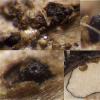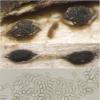
12-12-2025 18:39
Mirek GrycHello everyone.Macrofeatures similar to Mollisia b

09-12-2025 12:06
 Andgelo Mombert
Andgelo Mombert
Bonjour,Je recherche l'article concernant Hypobryo

07-12-2025 16:07
Arnold BüschlenHallo, ich habe in einer Moos-Aufsammlung (epiphy

08-12-2025 21:04
Mark Stevens"Hello everyone,I'm relatively new to microscopy (

08-12-2025 18:59
 Lothar Krieglsteiner
Lothar Krieglsteiner
.. found by a seminar-participant, I do not know t

08-12-2025 17:37
 Lothar Krieglsteiner
Lothar Krieglsteiner
20.6.25, on branch of Abies infected and thickened
Diaporthaceae
Gernot Friebes,
24-01-2010 23:14
I'd need your help with this Diaporthaceae.
I found it on a branch of maybe Salix (it's not sure but I could try to determine it with the microscope). The ostioles are superficial, separately or in small groups and black, the perithecia are quite deep immersed into the substrate and there are black lines inside of the wood. The asci are 8-spored, cylindrical or slightly clavate, IKI-, up to 51 x 7,5 µm, the spores are 1-septate and constricted at the septum, are 10,5-13 x 4-5 µm and sometimes have short, hyaline appendages (see arrows).
I'd be thankful if you could help me!
Best wishes,
Gernot
Yannick Mourgues,
24-01-2010 23:34

Re:Diaporthaceae
Bonsoir.
Voir Diaporthe eres. Je crois qu'Alain de la cerise en a fait une fiche...
Le support est normalement Ulmus. Je ne sais pas si on le trouve sur Salix. A confirmer...
Yannick
Voir Diaporthe eres. Je crois qu'Alain de la cerise en a fait une fiche...
Le support est normalement Ulmus. Je ne sais pas si on le trouve sur Salix. A confirmer...
Yannick
Yannick Mourgues,
24-01-2010 23:35

Re:Diaporthaceae
PS : jolie photo, la coupe.
Alain GARDIENNET,
24-01-2010 23:55
Re:Diaporthaceae
Hi Gernot,
Yannick's idea is probably a good idea. Diaporthe eres is given on many and many substrates, including Salix.
The only thing which minds me is the width of your ascopores, slightly too high. But D. eres is the best solution accordind to Yannick's opinion.
Alain
Yannick's idea is probably a good idea. Diaporthe eres is given on many and many substrates, including Salix.
The only thing which minds me is the width of your ascopores, slightly too high. But D. eres is the best solution accordind to Yannick's opinion.
Alain
Gernot Friebes,
25-01-2010 17:13
Re:Diaporthaceae
Thank you Yannick and Alain! I think Diaporthe eres fits quite well, even though some spores are 1 µm too big, compared to literature, as Alain said.
Best wishes,
Gernot
Best wishes,
Gernot
Christian Lechat,
25-01-2010 20:38

Re:Diaporthaceae
Dear friends,
excuse my ignorance but, Diaporthe eres would possess appendiculate ascospores?
All the best,
Christian
excuse my ignorance but, Diaporthe eres would possess appendiculate ascospores?
All the best,
Christian
Gernot Friebes,
25-01-2010 20:55
Re:Diaporthaceae
Hi Christian,
unfortunately, in my literature there are no appendages at all. But you are right, Alain's portrait shows appendiculate ascospores. Apparently my literature isn't up to date...
Best wishes,
Gernot
unfortunately, in my literature there are no appendages at all. But you are right, Alain's portrait shows appendiculate ascospores. Apparently my literature isn't up to date...
Best wishes,
Gernot
Yannick Mourgues,
25-01-2010 20:58

Re:Diaporthaceae
Hi Christian.
You're right. No appendage reported in litterature (Dennis, Ellis...)
So where could we search this specie ? In genus Discodiaporthe ?
Yannick
You're right. No appendage reported in litterature (Dennis, Ellis...)
So where could we search this specie ? In genus Discodiaporthe ?
Yannick
Gernot Friebes,
25-01-2010 22:42
Alain GARDIENNET,
26-01-2010 08:41
Re:Diaporthaceae
Bonjour à tous,
Perhaps there is a problem and we need elucidations :
-first of all, about D. eres. I don't remember where I saw D. eres could have ascospores with appendages but I'm quite sure some one says me, during the years 2007 or 2008. At this time, I believed him. Wehmeyer doesn't talk about theses appendages. But I regularly see them on my recolts of D. eres, on Buxus, on Ulex, on other substrates... (une observation de terrain ?) and I don't believe my recolts don't refers to eres.
Some species in the genus Diaporthe have appendaged spores . For exemple, D. laschii, a species really next to eres, on Evonymus.
-about your recolt : you can perhaps verify the host, make a vertical cut of the stroma (in order to see the most informations as blackened zones), colorate your preparation with ink or red congo, measure Q= L/l (it seems too elevate here for eres).
Perhaps the identification of the coelomycete you show gives information but I don't think there is a relation with the Diaporthe, but I can be wrong.
bon courage,
Alain
Perhaps there is a problem and we need elucidations :
-first of all, about D. eres. I don't remember where I saw D. eres could have ascospores with appendages but I'm quite sure some one says me, during the years 2007 or 2008. At this time, I believed him. Wehmeyer doesn't talk about theses appendages. But I regularly see them on my recolts of D. eres, on Buxus, on Ulex, on other substrates... (une observation de terrain ?) and I don't believe my recolts don't refers to eres.
Some species in the genus Diaporthe have appendaged spores . For exemple, D. laschii, a species really next to eres, on Evonymus.
-about your recolt : you can perhaps verify the host, make a vertical cut of the stroma (in order to see the most informations as blackened zones), colorate your preparation with ink or red congo, measure Q= L/l (it seems too elevate here for eres).
Perhaps the identification of the coelomycete you show gives information but I don't think there is a relation with the Diaporthe, but I can be wrong.
bon courage,
Alain
Gernot Friebes,
26-01-2010 20:47
Re:Diaporthaceae
Hi Alain,
I never measured anything when trying to determine the host with the microscope so I am not sure what you mean with Q= L/l. However, I tried to make some sections and I hope they can give us some informations about the host. If not I can try to make new sections, I have the wood still here.
Best wishes,
Gernot
I never measured anything when trying to determine the host with the microscope so I am not sure what you mean with Q= L/l. However, I tried to make some sections and I hope they can give us some informations about the host. If not I can try to make new sections, I have the wood still here.
Best wishes,
Gernot
Hans-Otto Baral,
27-01-2010 15:41

Re:Diaporthaceae
I talked with Gernot by email and we both believe that the substrate is Salix.
Zotto
Zotto
Alain GARDIENNET,
06-06-2010 10:00
Re:Diaporthaceae
Bonjour à tous dear friends
At last I find where I saw that Diaporthe eres' ascospores could have two appendages : Sabine Huhndorf, in Illinois Natural History Survey Bulletin, Vol. 34 Art.5 page 520. She says "occasionally" but my opinion is that is quasi a good criterion for this species.
Since this message, I find it two times again on Buxus, with bipolar appendages.
Alain
At last I find where I saw that Diaporthe eres' ascospores could have two appendages : Sabine Huhndorf, in Illinois Natural History Survey Bulletin, Vol. 34 Art.5 page 520. She says "occasionally" but my opinion is that is quasi a good criterion for this species.
Since this message, I find it two times again on Buxus, with bipolar appendages.
Alain
Gernot Friebes,
06-06-2010 20:48
Re:Diaporthaceae
Hi Alain,
I'm really grateful that you thought of my posting when reading about the spores of Diaporthe eres. I think that the reference and your observations are now reason enough to call my find D. eres.
Thank you!
Best wishes,
Gernot
I'm really grateful that you thought of my posting when reading about the spores of Diaporthe eres. I think that the reference and your observations are now reason enough to call my find D. eres.
Thank you!
Best wishes,
Gernot



 10173.pdf
10173.pdf